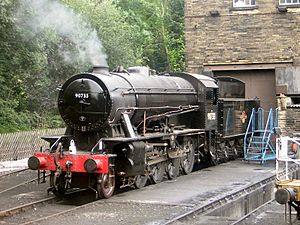BR ex-WD Austerity 2-8-0 facts for kids
Quick facts for kids BR ex-WD Austerity 2-8-0 |
|
 |
|
| 90474 at Woodford Halse, 1964 | |
| Power type | Steam |
|---|---|
| Designer | R.A. Riddles |
| Builder | |
| Build date | 1943–45 |
| Total production | 733 |
| Configuration | 2-8-0 |
| UIC classification | 1′D h2 |
| Gauge | 4 ft 8 1⁄2 in (1,435 mm) |
| Leading wheel diameter | 3 ft 2 in (965 mm) |
| Driver diameter | 4 ft 8+1⁄2 in (1,435 mm) |
| Length | 63 ft 6 in (19.35 m) over buffers |
| Axle load | 15 long tons 12 cwt (34,900 lb or 15.9 t) |
| Weight on drivers | 61 long tons 5 cwt (137,200 lb or 62.2 t) |
| Locomotive weight | 70 long tons 5 cwt (157,400 lb or 71.4 t) |
| Tender weight | 55 long tons 10 cwt (124,300 lb or 56.4 t) |
| Fuel type | Coal |
| Fuel capacity | 9 long tons 0 cwt (20,200 lb or 9.1 t) |
| Water capacity | 5,000 imperial gallons (23,000 L; 6,000 US gal) |
| Boiler pressure | 225 lbf/in2 (1.55 MPa) |
| Fire grate area | 28.6 sq ft (2.66 m2) |
| Heating surface: Tubes | 1,068 sq ft (99.2 m2) |
| Heating surface: Flues | 451 sq ft (41.9 m2) |
| Heating surface: Firebox | 168 sq ft (15.6 m2) |
| Superheater type | 28-element Melesco |
| Superheater area | 298 sq ft (27.7 m2) |
| Cylinders | Two, outside |
| Cylinder size | 19 in × 28 in (483 mm × 711 mm) |
| Valve gear | Walschaerts |
| Valve type | 10-inch (250 mm) piston valves |
| Tractive effort | 34,215 lbf (152.20 kN) |
| Power class | 8F |
| Axle load class | Route availability 6 |
| Withdrawn | 1959-1967 |
| Disposition | All scrapped. |
The British Railways (BR) ex-WD Austerity 2-8-0 was a class of 733 2-8-0 steam locomotives designed for heavy freight. These locomotives of the WD Austerity 2-8-0 type had been constructed by the War Department, as war locomotives 1943–1945. After the war, they were surplus and so in 1946 the LNER bought 200 of them, classifying them as LNER Class O7, and by the end of 1947 when the LNER was nationalised, had taken another 278 O7s on loan. After nationalisation, BR purchased 533 more 2-8-0s, including all of those on loan, giving a class total of 733. As many of these needed overhauling before being put to work, they were activated slowly. BR chose to reclassified from LNER Class O7 and renumbered them from the 6xxxx LNER series in the 90000–732 series for BR standard designs.
Naming
90732 was named Vulcan after the Vulcan Foundry.
Classification
BR considered them as standard classes, numbering them in the numbering series allocated for BR standard classes, assigned them the boiler diagram BR10; while their tenders were assigned the diagram BR5. BR built 53 new boilers at Crewe between 1951 and 1954.
Operation
The class were used almost entirely on freight services, and were always unusual on passenger work. Well over half the total number were always on the former LNER system, from East Anglia up to Scotland, and there was also a large number across the former Lancashire & Yorkshire railway depots. Some were initially used on the Southern Region, but later left there, while another smaller group was on the Western Region for much of their lives. The Scottish ones later spread from just the ex-LNER lines across the rest of the Region.
Accidents and incidents
- On 16 January 1958, locomotive 90277 was standing foul of the line at Preston when it was run into by a passenger train due to a signalman's error. The passenger train was derailed, 90277 ended up on its side. Thirteen people were injured.
Withdrawal
The engines were withdrawn from service as follows:
| Year | No. withdrawn | Nos |
|---|---|---|
| 1959 | 1 | 90083 |
| 1960 | 2 | 90062 etc. |
| 1961 | 0 | |
| 1962 | 80 | |
| 1963 | 97 | |
| 1964 | 125 | |
| 1965 | 201 | |
| 1966 | 104 | |
| 1967 | 123 |
Preservation
None of the BR Austerity 2-8-0s was preserved. However, one Austerity 2-8-0 (out of a total of 935 engines) has survived; WD No. 79257. This has returned to Britain via the Netherlands and Sweden, and has been restored to original condition and given the "BR number" 90733. It is based at the Keighley and Worth Valley Railway.
See also


